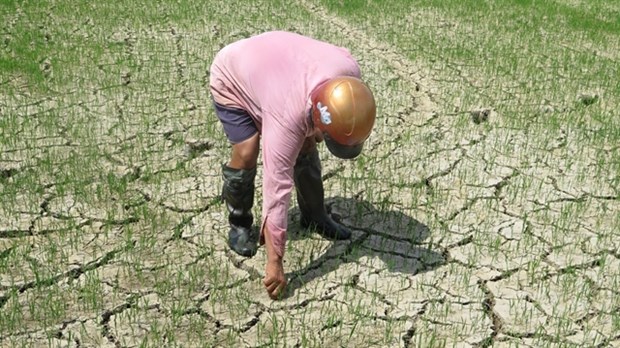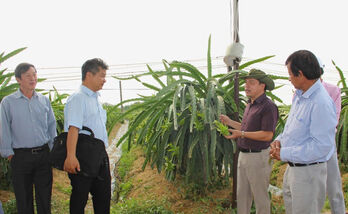
Parched land after a drought in Phu Yen province in 2022. (Photo: VNA)
A report by the Department of Irrigation, under the Ministry of Agriculture and Rural Development, reveals that current water storage levels in reservoirs across the North, Central Highlands, and Southeast regions are at approximately 40-50% of their design capacity.
In the Central region, the storage levels range from 50-70% of the design capacity.
Several hydroelectric reservoirs are consistently replenishing water downstream, although at reduced levels compared to the average over many years. For instance, Ban Ve reservoir is at 38% capacity, which is 14% lower than the historical average, and A Vuong reservoir is at 44% capacity, reflecting an 18% decrease.
Between approximately 10,000 and 15,000ha of rice cultivation face imminent risks of drought and water scarcity. The Irrigation Department has expressed concerns regarding the preparation for autumn and summer rice cultivation, particularly in the Central region, which has not yet entered the rainy season and remains vulnerable to water shortages.
Based on extensive forecasting, water source calculations and careful water allocation, the anticipated area at risk of water scarcity during the upcoming summer-autumn crop is estimated to be around 10,000-15,000ha. The North Central region accounts for approximately 7,500-10,000ha at risk, while the South Central region faces a potential water shortage on approximately 3,000-3,500ha.
During a meeting held on March 15 organised by the Ministry of Agriculture and Rural Development to discuss the implementation of urgent measures in response to the risks of heat, droughts, water shortages and saltwater intrusion, Do Van Thanh, Director of the Institute of Irrigation Planning, highlighted the cyclical nature of the El Nino phenomenon, which typically occurs every two years and can last up to three years.
Given this pattern, it becomes crucial to estimate the cycle and establish a long-term plan for direction and response. The current year has entered the rainy season, implying that any drought conditions will likely be mild. However, next year is anticipated to be a year of severe droughts, particularly affecting the Mekong Delta, South Central Coast, and Central Highlands regions.
Thanh emphasised the need to balance and recalculate each water source within sub-regions in the short term to identify areas susceptible to drought and develop corresponding plans.
In the long term, he proposed the establishment of weekly forecast bulletins to provide regular guidance, particularly focusing on the Central region and the Central Highlands.
Tran Dinh Hoa, Director of the Vietnam Institute of Irrigation Science, further emphasised the importance of developing frameworks and scenarios at multiple levels to guide and manage responses on an annual basis.
Hoa also drew attention to the likelihood of a severe drought occurring in the Mekong Delta next year, assuming it follows the expected pattern. Consequently, it becomes crucial to prepare appropriate solutions to mitigate the impact.
Additionally, he emphasised the importance of increasing the number of monitoring and evaluation points to enhance the accuracy of drought and saltwater intrusion forecasts and warnings.
Response plan for 2025
In light of these circumstances, it is essential to formulate a comprehensive drought response plan that extends until 2025, experts said.
Nguyen Nhu Cuong, Director of the Department of Crop Production, recalled the significant impact of the 2014 El Nino and the subsequent record drought during the 2015-16 winter-spring crop. These past events serve as valuable lessons, underscoring the urgency of devising effective strategies to safeguard agricultural activities in the face of impending challenges.
With the anticipated duration of the El Nino phenomenon spanning two years, it is highly likely that the 2024-25 winter-spring cropf will be severely affected, particularly in the Mekong Delta and other regions.
Consequently, it is of great importance to commence the development of a monthly and quarterly plan without delay.
It is also essential to conduct assessments to determine the areas most susceptible to droughts and evaluate their production water supply capacity.
Special attention should be given to identifying key areas that experienced droughts during the 2015-16 period, he said.
Furthermore, it is crucial to forecast water sources from the present until 2025, even extending the projections to 2026, to enable prompt implementation of appropriate solutions.
Deputy Minister of Agriculture and Rural Development Nguyen Hoang Hiep has said that the ministry intends to dispatch an inspection team to key areas at risk.
He urged specialised agencies to develop tailored forecasts and solutions spanning the period until 2025. Special emphasis should be placed on the Central Highlands, Mekong River Delta, and Central regions, with the utmost priority given to ensuring sufficient water supply for essential activities such as daily living, industrial production, and agricultural activities./.
VNA
 Collective economy—a sustainable direction to escape poverty
Collective economy—a sustainable direction to escape poverty



